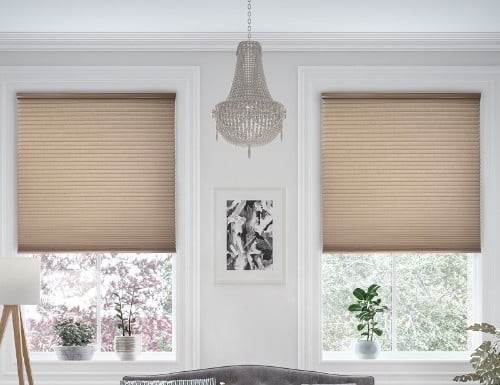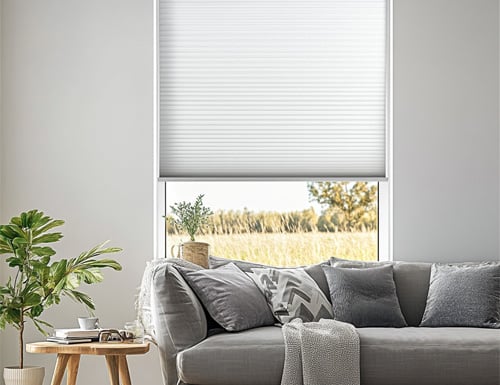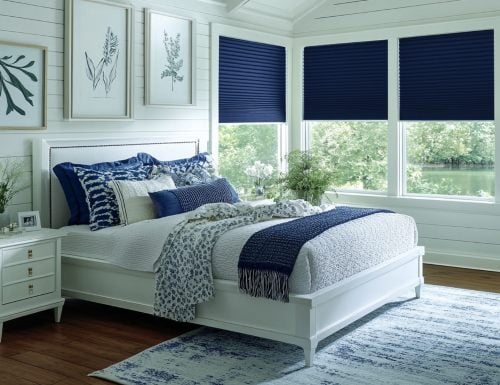Lexi Westingate | Blinds Chalet Design Team
Updated: Sep 3 2024

Introduction: Optimizing Your Window Treatments
When selecting honeycomb cellular shades, one of the key decisions you’ll need to make is whether to choose single cell or double cell shades. Understanding the differences between these options, as well as the different cell sizes available, can help you make an informed choice that best suits your needs. This guide will delve into the specifics of single cell and double cell shades, explain the benefits of each, and provide recommendations for their best use cases in homes and offices.
1. What Are Single Cell and Double Cell Shades?
Single Cell Shades
Single cell shades feature a single layer of honeycomb cells. These shades consist of individual cells that trap air, providing a moderate level of insulation and energy efficiency. They are generally less expensive and have a sleeker profile compared to double cell shades.
- Structure: One layer of cells.
- Insulation: Provides basic insulation by trapping air in the single layer of cells.
- Appearance: Slimmer profile, ideal for windows with shallow mounting depths.
Double Cell Shades
Double cell shades, as the name suggests, have two layers of honeycomb cells stacked on top of each other. This design creates additional air pockets, enhancing the insulation properties and energy efficiency of the shades. Double cell shades are typically thicker and offer greater temperature control and sound absorption.
- Structure: Two layers of cells, creating additional air pockets.
- Insulation: Superior insulation due to the double layer of air pockets.
- Appearance: Thicker profile, providing a more substantial look and feel.
2. Cell Sizes and Their Impact
Small Cells (3/8 inch)
- Insulation: Good insulation, ideal for smaller windows.
- Appearance: Sleek and minimal, suitable for a modern look.
- Best Use: Small to medium-sized windows in homes and offices where a slim profile is desired.
Medium Cells (1/2 inch)
- Insulation: Better insulation than small cells, versatile for various window sizes.
- Appearance: Balanced profile, suitable for most standard windows.
- Best Use: Medium to large windows, providing a good balance between insulation and aesthetics.
Large Cells (3/4 inch and above)
- Insulation: Excellent insulation, best for large windows.
- Appearance: More prominent look, ideal for a bold statement.
- Best Use: Large windows or sliding glass doors, offering maximum insulation and coverage.
3. Best Use Cases for Single and Double Cell Shades
Single Cell Shades
Single cell shades are versatile and can be used in various settings. Their slimmer
profile makes them ideal for windows with limited mounting space.
Homes:
- Living Rooms: Single cell shades provide sufficient insulation while maintaining a sleek look that complements modern decor.
- Kitchens: They offer light control and privacy without taking up much space.
Offices:
- Small Office Windows: Ideal for smaller office windows where a streamlined appearance is preferred.
- Meeting Rooms:: Provide a balance between light control and aesthetics.
Double Cell Shades
Double cell shades are perfect for areas where superior insulation and sound absorption are required. Their thicker profile also adds a touch of luxury to the decor.
Homes:
- Bedrooms: Double cell shades offer excellent temperature control, ensuring a comfortable sleeping environment year-round.
- Media Rooms: Their superior sound absorption makes them ideal for media rooms, reducing outside noise for an enhanced viewing experience.
Offices:
- Conference Rooms: Provide privacy, sound absorption, and temperature control, creating a conducive environment for meetings.
- Large Windows: Perfect for offices with large windows, helping to regulate temperature and reduce energy costs.
4. Choosing the Right Cell Size and Type
When choosing between single cell and double cell shades, and deciding on the cell size, consider the specific needs of each room:
- Energy Efficiency: For maximum energy savings, double cell shades with large cells are the best choice.
- Aesthetics: For a sleek, modern look, single cell shades with small or medium cells are ideal.
- Light Control and Privacy: Both single and double cell shades offer good light control and privacy, but double cell shades provide additional benefits in terms of insulation and sound absorption.
Conclusion: Making an Informed Choice
Choosing the right honeycomb cellular shades involves balancing aesthetics, functionality, and specific needs. Single cell shades offer a slim profile and sufficient insulation for most settings, while double cell shades provide superior energy efficiency and sound absorption. By considering the size of the cells and the specific requirements of each room, you can select the perfect shades to enhance your home or office.
Explore the extensive range of honeycomb cellular shades at BlindsChalet.com to find the ideal solution for your window treatment needs. With customizable options and expert advice, you’re sure to find shades that perfectly match your style and functional requirements.













